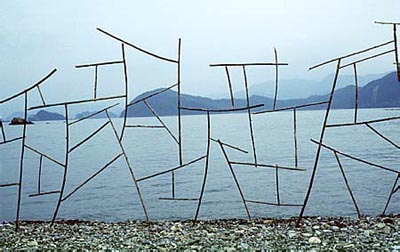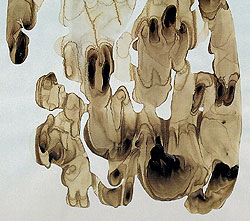Andy Goldsworthy's Collaborations with Nature
 As I noted last week, in David Attenborough's documentaries, the natural world is teeming, bizarre place of baroque mating rituals, predation, and survival. A more bucolic view of nature is one that looks at the beauty in natural forms and patterns. One of the themes in Zymoglyphic culture is making art from natural objects, often with minimal transformation. Andy Goldsworthy is the purest Western practitioner of the craft of arranging natural materials into art forms. Usually, it is a matter of lightly imposing some human abstraction - a circle, spiral, or an unnatural crack - in a natural landscape to somehow achieve a magical effect. Some of his creations are permanent installations in stone, but most are ephemeral structures of ice, leaves, water, sticks or the crackles in drying mud. For these, his photographs become the final creative product and only remaining evidence of the work. The photographs in turn are available in a series of high-quality books. A good survey is Andy Goldsworthy: A Collaboration with Nature
As I noted last week, in David Attenborough's documentaries, the natural world is teeming, bizarre place of baroque mating rituals, predation, and survival. A more bucolic view of nature is one that looks at the beauty in natural forms and patterns. One of the themes in Zymoglyphic culture is making art from natural objects, often with minimal transformation. Andy Goldsworthy is the purest Western practitioner of the craft of arranging natural materials into art forms. Usually, it is a matter of lightly imposing some human abstraction - a circle, spiral, or an unnatural crack - in a natural landscape to somehow achieve a magical effect. Some of his creations are permanent installations in stone, but most are ephemeral structures of ice, leaves, water, sticks or the crackles in drying mud. For these, his photographs become the final creative product and only remaining evidence of the work. The photographs in turn are available in a series of high-quality books. A good survey is Andy Goldsworthy: A Collaboration with Nature A lesser-known type of work that he does are "snowball paintings", which are created by putting a snowball stained with a natural dye on paper and letting it melt. The result is an amazingly detailed pattern created by the way the dye is deposited as the snow melts and the water evaporates. A detail from one is shown here, with an enlargement here. The Zymoglyphic acrylic paintings achieve a similar effect from the deposition patterns of the (unnatural) acrylic pigment.
A lesser-known type of work that he does are "snowball paintings", which are created by putting a snowball stained with a natural dye on paper and letting it melt. The result is an amazingly detailed pattern created by the way the dye is deposited as the snow melts and the water evaporates. A detail from one is shown here, with an enlargement here. The Zymoglyphic acrylic paintings achieve a similar effect from the deposition patterns of the (unnatural) acrylic pigment. An additional dimension to Goldsworthy's work is provided in the excellent documentary Rivers & Tides
He has two permanent installations in the Bay Area. One is Stone River in front of the Cantor Arts Center on the Stanford University campus, and the other
is at the de Young Museum in Golden Gate Park.


0 Comments:
Post a Comment
Links to this post:
Create a Link
<< Home